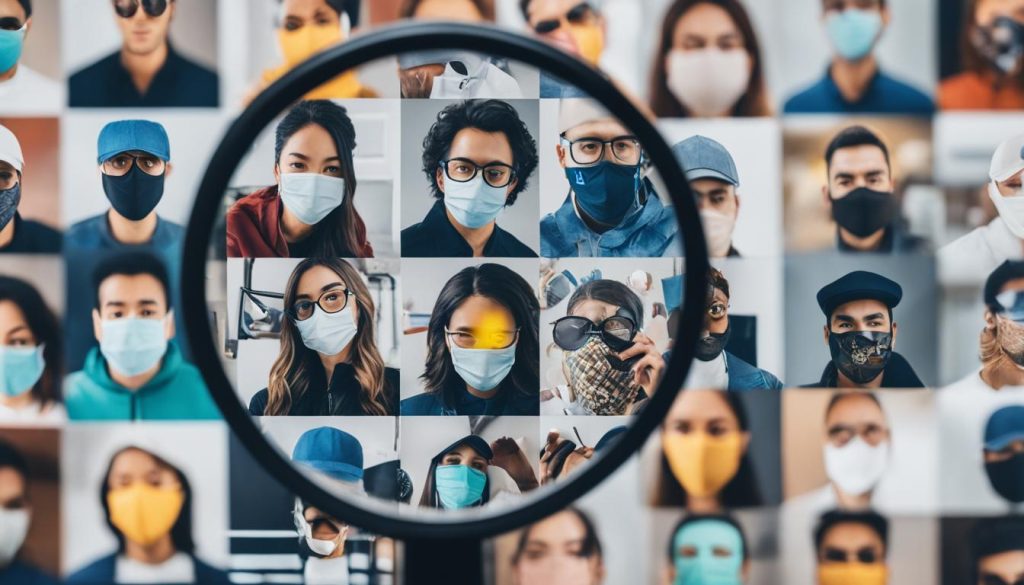As Instagram continues to capture the hearts of millions, the platform also finds itself entangled with the rise of fake accounts, morphing from a minor nuisance into a grave concern for many users. In 2020, it was estimated that 95 million bot accounts infiltrated Instagram, creating more than just spam—they posed real threats, from identity theft to privacy breaches. Knowing how to find who is behind a fake Instagram account, to track down a fake Instagram account, and ultimately to identify a fake Instagram account owner have become essential skills in the era of digital transparency and authenticity. Dive in as we explore the underbelly of Instagram’s counterfeit culture and arm you with the know-how to spot and decipher these digital masqueraders.

Key Takeaways
- Understanding the reasons behind the proliferation of fake Instagram accounts can alert users to potential risks.
- Knowing common characteristics of fake accounts can help in their identification and avoidance.
- Being vigilant and analytical with account activities serves as the first line of defense against imposters.
- Recognizing the signature traits of bots and spam accounts allows for a cleaner, safer online experience.
- Technology and advanced tools serve as allies in the battle to protect personal information and brand identity on social media.
The Growing Threat: Understanding Fake Instagram Accounts
To understand how to trace a fake Instagram account or reveal the identity of its creator, one must first recognize the scale of the problem. The inundation of bot accounts on Instagram has become a significant concern that challenges the platform’s credibility and user safety.
Estimated Millions of Bot Accounts
The sheer volume of automated bots on Instagram is staggering. While not all bots are malicious, the proliferation of fake accounts has become a tool for deception and manipulation. These accounts are often difficult to distinguish from real users, making the effort to uncover the identity of a fake Instagram user an ever more daunting task.
How They Compromise User Experience
Fake accounts deteriorate the social media experience. They not only inundate feeds with spam and irrelevant content but also pose security risks. Their use in phishing schemes, for instance, exemplifies how they can lead to personal data breaches. This underlines the importance of efforts to reveal the fake Instagram account creator and mitigate the associated risks.
Here’s a closer look at how these accounts can disrupt the digital environment:
| Issue | Impact on Users | Risks Involved |
|---|---|---|
| Spam Content | Cluttered Feed | Reduced Quality of User Experience |
| Masquerading As Real Users | Misplaced Trust | Identity Theft, Scams |
| Unauthorized Promotions | Annoyance and Deception | Financial Fraud |
| Phishing Attempts | Compromised Personal Information | Security Breaches |
Understanding these impacts is imperative for online safety. As Instagram continues to combat these fake accounts, users must also remain vigilant to trace and tackle the fake Instagram accounts that emerge amidst genuine interactions.
Why Fake Instagram Accounts Flourish
The digital world has grappled with the challenges posed by fake Instagram accounts. A quest for anonymity and the desire for social recognition power this unabated rise. What drives some individuals to expose fake Instagram account holders or identify fake Instagram account owners is the perplexing array of motives intertwining throughout the social media landscape.
Anonymity online can be a double-edged sword: a tool for freedom of expression for some, and a weapon for malicious intent for others. The veil of anonymity allows individuals to engage in cyberbullying with reduced fear of consequences, targeting unsuspecting users to inflict harm or distress. Catfishing, another troubling trend, lures individuals into relationships founded on deceit, with fake personas leading to real emotional turmoil.
On a broader scale, some create fake accounts to spread misinformation or execute online scams, undermining the platform’s integrity. Then there are those who simply experiment with the boundaries of digital personas, testing the limits of Instagram’s policy enforcement. Each of these reasons contributes to the confusing proliferation of counterfeit accounts, impacting genuine users’ experience.
- Anonymity as a Cover for Harassment
- Social Validation Fuels Dishonest Relationships
- Misinformation and Online Scams
- Experimentation with Digital Boundaries
Despite Instagram’s rigorous efforts to maintain authenticity, the undercurrents of human behavior and technology’s flaws allow these accounts to not only exist but also flourish. Online accountability becomes increasingly challenging as we struggle to expose fake Instagram account holders and preserve the platform’s intended purpose of authentic and meaningful social interaction.
Identifying the Imposters: Characteristics of Fake Instagram Profiles
When attempting to track down fake Instagram accounts and uncover the identity of a fake Instagram user, specific profile characteristics can be undeniably revealing. Users should be on alert for signs that typically indicate a profile might not be as genuine as it appears. Spotting these signs requires a mix of vigilance and awareness of common tactics used by imposter accounts.
Zero Content Posts
An obvious red flag is the presence of no or very few posts on a profile. Users should question the legitimacy of an account when it appears barren of content. This absence often implies that the account exists not for engagement but for ulterior motives such as stalking or outright spamming. Certain tools and algorithms have been designed to help social media users sift through these dubious profiles rapidly.
Inconsistent Branding and Imagery
Inconsistency in branding and imagery is another hallmark of a potentially fake Instagram profile. Notable characteristics include the use of low-resolution images, an array of stock photos, or graphics that lack a cohesive theme. These profiles seldom provide a genuine insight into the user, typically because there is no real user behind them.
About Followers and Following: Unbalanced Ratios
Finally, the ratio of followers to following can provide invaluable clues. An authentic account typically maintains a ratio that reflects human social behavior, whereas fake accounts may have a significantly high number of follows with a disproportionately low number of followers or vice versa, indicating artificial inflation to create an illusion of popularity or engagement.
| Characteristic | Description | Reason for Suspicion |
|---|---|---|
| Zero Content | No posts on the profile or very few posts over an extended period. | Suggests the account’s purpose is surveillance or spam rather than engagement. |
| Branding Inconsistency | Mismatched images and graphics that do not tell a coherent story about the user or brand. | Points to a lack of authenticity and personal identity, characteristic of fake profiles. |
| Unbalanced Follower-Following Ratio | An abnormal number of follows or followers that doesn’t match typical user patterns. | May indicate the use of bots or services to artificially inflate the account’s perceived popularity. |
By familiarizing oneself with these common traits, users can become more astute in their ability to track down fake Instagram accounts and uncover the identity of a fake Instagram user. Awareness and proactive scrutiny serve as the first line of defense in the digital world’s ongoing battle against online impersonation and fraud.
How to Find Who Is Behind a Fake Instagram Account
The quest to trace a fake Instagram account often feels like navigating through a digital maze without a clear start or end. However, the pervasiveness of fake profiles on social platforms necessitates a sharpening of our digital detective skills. If you’re grappling with the question of how to find who is behind a fake Instagram account, the solution requires a blend of observation, analytical thinking, and the utilization of some savvy online tools.
Initially, you should scrutinize the profile for any clues that may signal its inauthenticity. Look for telltale signs such as generic or pixelated profile images, a sparse or non-existent posting history, and a following-to-follower ratio that seems suspiciously unbalanced. These anomalies often betray a profile’s lack of genuine social engagement and may suggest that the account is far from what it purports to be.

Should these superficial investigations yield no definitive answers, the next phase involves a deeper analytical approach. Perhaps the account has engaged with other users or left comments across various posts. By examining these digital footprints, it’s possible to garner hints about the individual’s pattern of behavior, the nature of the content they share, or even the language they use, which can be instrumental in unmasking the person behind the facade.
Advanced online tools empower users with a more proactive stance in their quest to trace fake Instagram accounts. Reverse image searches can unveil the origin of profile pictures and uncover if the same image is being utilized on different accounts or platforms. Additionally, the examination of metadata in shared photos or the analysis of IP addresses accessed by the account may lead to breakthroughs in your investigation.
Invariably, your efforts to unmask fake Instagram accounts will intersect with privacy and ethical considerations. It’s important to remember that while transparency and authenticity are valuable, they must be pursued within the bounds of respect for individual privacy and legal frameworks.
Ultimately, the digital realm is often a mirror of the complexities of the real world; persistent, informed, and ethical inquiry is our best tool to guarantee the integrity of our virtual interactions and communities.
Steps to Safeguard Against Instagram Fakes
In the quest to protect your brand from social media impersonation and maintain the integrity of your online presence, developing a defensive strategy is essential. It starts with a discerning eye toward the activity that happens on your account and extends to deploying cutting-edge digital solutions. By equipping yourself with knowledge and the right tools, you can take proactive measures to keep the counterfeit shadows at bay, ensuring a genuine and trust-filled platform for your audience and clients.
Analyze Account Activity
To effectively track down fake Instagram accounts, a detailed analysis of account activity is imperative. This means becoming a digital detective of sorts, scrutinizing the influx of interactions. Watch carefully how each post is responded to; do the patterns indicate genuine interest or automated responses? Anomalies in how users engage with your content can serve as a telltale beacon, signaling the presence of artificial entities amidst your digital audience.
Engagement Patterns: Unpacking the Analytics
Deep diving into your Instagram analytics unmasks the reality behind each like and comment. Engagement patterns hold the clues to discerning authentic interaction from mere facades. High volumes of engagement with little substance or relevance to the content may indicate compromised accounts or orchestrated deception. When seeking to identify fake Instagram account owners, these metrics play a pivotal role, offering insights that surface beyond the superficial data.
Utilize Advanced Tools and Services
Fortifying your defenses against imposters relies on more than just vigilance; it incorporates the savvy use of advanced tools and services. Incorporating applications like Botometer into your routine can greatly streamline the process of identifying and excluding insincere followers. These technological allies are instrumental in the ongoing battle to preserve the health of your social ecosystem, helping to protect your brand from social media impersonation and maintain valuable relationships with your true supporters.
FAQ
How can you identify if an Instagram account is fake?
To identify a fake Instagram account, look for signs such as a lack of posts, generic or stock images, a skewed follower-following ratio, minimal user interaction, and unusual patterns in their activity. High numbers of followings with very few followers or vice versa, as well as a recent account creation date, might also indicate a fake account.
What strategies can be employed to trace a fake Instagram account back to its creator?
Tracing a fake Instagram account back to its creator involves observing the account’s online behavior for consistency, using reverse image search tools to locate the source of profile pictures, and noting any digital traces linked to other social media platforms. It can be quite challenging, and sometimes professional expertise or law enforcement may be necessary if the account’s activity is illegal.
Is it possible to find out who is behind a fake Instagram account?
It might be difficult since fake account creators typically strive to hide their true identities. However, you may get closer to finding out by piecing together shared content, mutual followers, engagement patterns, and reverse-searching images. Law enforcement officials might be able to legally require Instagram to reveal the owner’s identity in serious cases involving harassment or other criminal behavior.
What should you do if you discover a fake Instagram account?
If you come across a fake Instagram account, you should report it to Instagram through their in-app reporting feature. Provide any evidence you have that the account is fraudulent, and avoid engaging with the account directly. It’s important to protect your own information and privacy while Instagram investigates your report.
Are there tools available to help you spot fake Instagram accounts?
Yes, there are various tools such as Botometer that analyze accounts to determine the likelihood of them being fake. These tools look at metrics such as the account’s engagement rate, the quality of their followers, and their posting habits to assess their authenticity. Additionally, analytics applications for Instagram can help spot irregularities in account activity.
Can the creation of fake Instagram accounts have legal repercussions?
Yes, creating fake Instagram accounts could lead to legal repercussions if they’re used for illegal activities such as harassment, fraud, impersonation, or copyright infringement. Instagram’s terms of service prohibit creating fake accounts. Depending on the jurisdiction, various laws may apply to cybercrimes associated with fake accounts.
Why do people create fake Instagram accounts?
People create fake Instagram accounts for various reasons like maintaining anonymity, cyberbullying, catfishing, attempts at financial scams, spreading misinformation, or even just for fun. The motives can range from harmless to malevolent, but they all contribute to the wider issue of digital deception and the complexities it introduces online.
How do fake Instagram accounts affect user experience on the platform?
Fake Instagram accounts can lead to a tainted user experience by polluting feeds with spam or irrelevant content, eroding trust among users, and presenting security risks through potential phishing attempts. They diminish the platform’s overall authenticity, making it harder for users to distinguish between genuine and bogus interactions.
What are the signs of an unbalanced follower-following ratio on Instagram?
An unbalanced follower-following ratio could present itself in a couple of ways. It may show an unusually high number of followers with minimal content posted, which could indicate bought or fake followers. Conversely, it could be an account that follows a large number of users but has very few followers in return, possibly signifying spamming intentions.
To protect your brand from social media impersonation, regularly monitor your brand’s presence online, set up alerts for when your brand is mentioned, report and take action against impersonators, educate your audience on how to identify the official account, and consider verification to assure your followers that your social media profile is the authentic source of information for your brand.

Hey there, I’m Wesley! Passionate about all things social platforms, I founded this blog to decode the ever-changing landscape of likes and shares. If you’re looking to up your social game, you’re in the right place. Let’s make your feed something to talk about!




